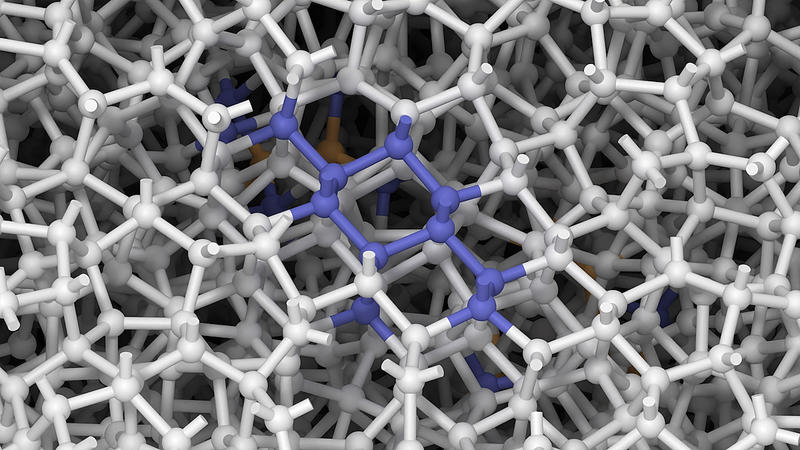Amorphous materials do not have long-range structural order, and yet there are subtle rules that determine their atomic-scale structure. In a new study, Oxford researchers argue that signatures of local “paracrystalline” order can provide a more complete picture of the amorphous state than fully random models.
The study, published this week in Nature Communications, is focused on amorphous silicon (a-Si), which is used in photovoltaic cells and is one of the most widely studied disordered networks. The authors used advanced computer simulations, based on quantum mechanics and machine learning, to create a library of a-Si structures with varying degrees of local order.

A “paracrystalline” structural fragment, highlighted in blue, within a disordered network of silicon atoms. Image credit: Louise Rosset
The work was led by Louise Rosset, a senior DPhil student in the Deringer group in Oxford‘s Inorganic Chemistry Laboratory. She commented:
There has been a long-standing debate on whether a-Si can be understood as a completely random network or if it has some degree of ordering, with contradicting evidence supporting both sides. We challenge the previous argument of the ordering as large, strained crystals in an otherwise amorphous matrix. Here, we unify both arguments with a revised paracrystalline model, where ordering manifests as small, localized clusters that affect the medium range order. Remarkably, while there is localized order, the structure remains disordered.
The authors collaborated with Prof David Drabold, Distinguished Professor at Ohio University and renowned expert on the “random versus paracrystalline” debate. He noted:
This study enhances our understanding of a material employed in photovoltaics, thin-film transistors and perhaps soon even gravitational wave observatories. While the existence of small crystallites in samples of a-Si has long been suspected, almost nothing was known about their linkages to each other or to more disordered parts of the material. This work reveals in exquisite detail the energetics, local order, and the process of formation of the material, now realistically modelled across the full spectrum of order to disorder.
Prof Volker Deringer, senior author of the study, emphasised the role of simulations in the wider field beyond amorphous silicon alone:
Machine learning has changed the game in computational chemistry: we are now able to create nanoscale models of complex materials in atomistic detail and with quantum-mechanical accuracy. In this case, machine-learning-driven simulations have allowed us to better understand one of the ‘textbook’ amorphous solids, and we are excited to see how they can help us design improved and entirely new amorphous materials in the future.
The work is available openly in Nature Communications at https://doi.org/10.1038/s41467-025-57406-4, and was generously supported by a UKRI Frontier Research grant (Horizon Europe guarantee funding).